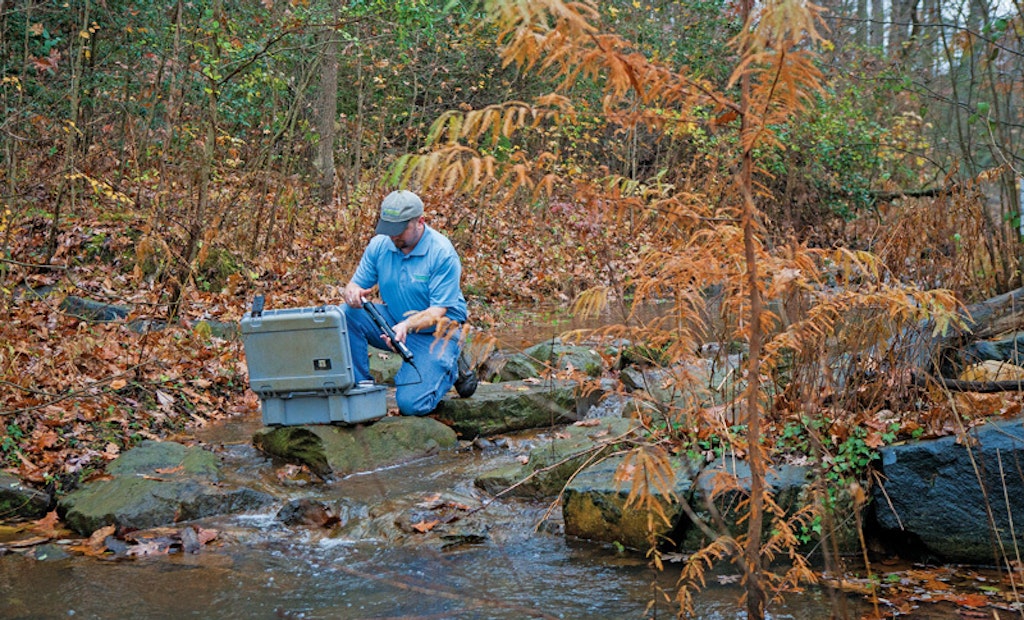
Innovative public-private partnerships are just one of a stream of steps Anne Arundel County, Maryland, is taking to reduce stormwater runoff, meet their Municipal Separate Storm Sewer System permit, and help achieve new Total Maximum Daily Load limits for phosphorus, nitrogen and sediment in the Chesapeake Bay.
The effort — titled the Anne Arundel County Watershed Protection and Restoration Program — is managed by the county’s Department of Public Works. Erik Michelsen is program administrator.
“We are under orders to implement the plan by the end of 2019,” Michelsen explains. “We are well along in implementing a number of specific projects that will enable us to meet our new MS4 permit.”
The projects include restoration of eroding and degrading areas like streambeds and outfall discharges into natural areas, retrofitting of old stormwater retention ponds, restoring shorelines and repairing infrastructure. Financial support comes from the county’s stormwater remediation fees, initiated in 2013.
The program includes a groundbreaking restoration grant program that incentivizes area nonprofit entities as well as the private sector to undertake restoration projects on their own property. “The county then gets credit for the restoration toward its permit requirements,” Michelsen explains. (More information on the grant program can be found at www.cbtrust.org.)
Anne Arundel County
Anne Arundel County is home to over 530,000 people and includes the state capital city of Annapolis. With over 500 miles of coastline along the Chesapeake Bay, the county is known for boating, fishing, crabbing, waterskiing, sailing and swimming. Baltimore is located just north of the county, and Washington, D.C., just to the southwest.
Like other large jurisdictions in the state, the county had been mandated to assess property owners a stormwater remediation fee to provide a dedicated source of revenue for stormwater management programs. The fee differs for residential versus commercial property owners, and is based on the amount of impervious surface area on the property and its zoning location in the community.
In addition, in 2010, the EPA had established new TMDL limits for the phosphorus, nitrogen and sediment in the Chesapeake Bay watershed, which includes most of the state of Maryland as well as Delaware, D.C., and parts of New York, Pennsylvania, Virginia and West Virginia.
“We knew the obligation (to restore the watershed and reduce pollutant discharges to the Bay) was coming in our renewed MS4 permit,” Michelsen says. That gave the county a head start in identifying, planning, designing and building critical projects.
Today, Michelsen says, the county is well along on implementing the plan. “We still have some watershed assessment work going on,” he explains, “but we’re about 90 percent complete (with that phase). We’re lucky in that — over the preceding decade — the county had spent funds and identified locations where restoration work could take place.
We’ve been able to put together a capital program and implement the work based on those assessments.”
The stormwater fees have been used to leverage bonds, pay debt service, cover staff expenses, and fund some of the watershed assessment and maintenance costs. Overall cost to meet the MS4 restoration requirements in the county is expected to be about $344 million.
Capital projects
Broadly speaking, the capital projects in the county’s WPRP fall into several specific categories:
- Stormwater facility retrofits
- Outfall projects
- Stream and wetland restoration
The stormwater facility retrofits involve improvements to old ponds or other facilities that were parts of the county’s initial flood control system, Michelsen explains. “These are mostly old dry ponds that were used for shaving peak flows, not really much in the way of water quality protection,” he says. “They provide a nice footprint for us to go back in and obtain storage as well as provide volume control. They’re really the low-hanging fruit in the overall project.”
The existing stormwater ponds near the Hospital Drive project in Glen Burnie provide an example. There, tree roots had penetrated the banks and during a rainstorm the trees could have collapsed into the ponds. The retrofitting of the pond created a more sustainable stormwater facility, according to the county’s website. The dam embankment was removed, and a rock-lined step pool storm conveyance system was installed, serving as an ecologically friendly way to safely convey stormwater flows while recharging the groundwater and reducing runoff. From an aesthetic standpoint, the pond looks a lot better, as well.
The outfall rebuilds are necessary because the county has quite a range of topography, with little bedrock and mostly erosive soil, according to Michelsen. He says pipes were discharging stormwater onto the sides of slopes, causing erosion and undermining the pipe structures. In the rebuild projects, eroded or failing stormwater outfalls are being reconstructed into systems that can move high flows as well as provide enhanced water quality and habitat enhancements.
In the Annapolis area, the county performed an emergency embankment breach and culvert repair within an old decommissioned railroad embankment. The failing culvert had caused several sinkholes to form, and stream flow appeared to be running through voids rather than confined within the existing pipe, posing a threat of flooding to the adjacent community. Repairs included the removal of the culvert, and establishment of a stable channel through the breached areas. Later phases of the repairs will include stormwater retrofits within the watershed, and restoration of upstream segments of the channel, north of the embankment.
Stream and wetland restoration
Perhaps the biggest bang for the buck in the Anne Arundel WPRP program has been stream and wetlands restoration projects. “It’s a big piece of the puzzle,” says Michelsen. Much of the sediment and phosphorus originates in the metropolitan core of the county, he explains, and high flows have created channels that funnel the pollutants downstream. Culverts exacerbate the problem.
“By restoring the streambeds, we connect the streams back to their riparian wetlands,” Michelsen says. “That provides a better aquatic habitat; there’s more water on the landscape.”
He says the projects have involved raising the stream bottom back up, filling the channel, and providing vertical grade control with wood or stone in order to connect the stream to its flood plain. In projects to excavate the flood plain, the issue is removing “legacy sediments” that have built up over the decades.
In the Warehouse Creek project, 970 linear feet of an unnamed tributary to the creek had become severely eroded and the stream channel had little connection to its floodplain. The area was overrun with invasive plants, as well.
The county installed an SPCS to stabilize the channel and connect the tributary to the flood plain. The system also enhanced nutrient uptake in the stream and the associated wetlands, and reduced sediment loading to Warehouse Creek. Native vegetation was planted to replace the invasive growth.
“Overall, we’ve got something on the order of 29 miles of stream rebuilding in the design process and several miles completed,” Michelsen says. “It’s pretty significant.”
While the county is working on over 200 capital projects in the three above categories, significant work is being accomplished in restoring shoreline areas and improving urban infrastructure.
Michelsen says the shoreline work provides additional credit toward its MS4 permit compliance, and involves stabilization of areas along Chesapeake Bay and its tributaries.
“We have 530 miles of shoreline, and while much of it is stable, there are areas that are rapidly eroding,” he says. The restoration work involves rebuilding dunes and beaches by placing sand and planting vegetation, and creating marsh areas. The work also improves the shoreline as a habitat for wildlife.
The WPRP also targets faulty infrastructure and fosters improved operational strategies. Michelsen says defective sewer lines are known to be leaking nutrients in urban areas, especially in low-lying stream valleys. “Our utility crews use CCTV to inspect the lines on a regular basis,” he says. “In some cases we walk the lines looking for leaks or overflows, and monitor water quality for spikes in bacteria.”
To remediate the issue, the county is repairing and patching pipes where necessary, or in some cases replacing entire pipe sections.
Septic systems and fertilizer runoff from lawns are other sources of pollution being addressed. “We have about 40,000 septic systems,” Michelsen says. “We don’t have much agriculture or farm runoff.”
On the operational side, the county is improving street sweeping in the Patapsco River watershed along Baltimore Harbor. An outside contractor uses vacuum-assisted sweepers to keep street debris and pollutants from running into the waterways. “We’re also doing a more thorough job of inlet cleaning,” Michelsen says.
Partnerships and communication
While the WPRP features many design innovations, the partnerships the county has developed with the private sector and area nonprofit organizations may be the most creative approach. It offers incentives for entities outside the public realm to participate in the restoration work, helping improve the environment of the watershed while adding to the county’s credits toward permit compliance.
Here’s how it works: Using funds available through the Chesapeake Bay Trust (www.cbtrust.org), the program offers restoration grants to nonprofit watershed groups, religious organizations, homeowners and private landowners to undertake restoration projects on their own property, in parallel with the county’s program.
The county evaluates the projects that are submitted under the program, evaluating them on a cost-per-pound of pollutants reduced, as well as the project timeline and acreage
covered. “We are looking for turnkey restoration projects that we can use toward meeting the county’s overall restoration goals,” Michelsen says. Participants receive payment once the projects are complete.
Throughout the watershed restoration and protection program, the county has overcome a number of challenges inherent in working with the private sector. Communication is key, Michelsen believes.
“We’ve done a lot of work on private property — negotiation, purchase of property; a lot of hurdles,” he says.
“Our approach has been to communicate effectively right from the outset — reaching out to landowners even before we engage a design consultant.” Another key is assigning specific project managers to specific geographic areas so they become familiar with the territory, and then making them accessible to the public.
The idea, Michelsen says, is to keep the affected parties engaged in the process — including inviting them to have a say in the design process. “We want projects that everybody is happy with,” he says. “It’s not a silver bullet, but so far, it has worked. It’s helped us create a relationship and build up a level of trust.”
Chesapeake Bay TMDLs
In December 2010, the US EPA issued TMDL limits for the Chesapeake Bay, noting that previous efforts to restore water quality in the Bay and its tidal tributaries had been ineffective.
According to the order, 60 percent of the practices designed to reduce nitrogen, phosphorus and sediment must be in place by the end of 2017. All measures must be in place by the end of 2025.
The order affects six states that are part of the Chesapeake Bay watershed, as well as the District of Columbia.
The overall targets of the order are a 25 percent reduction in nitrogen discharges to the Bay and its tributaries, a 24 percent reduction in phosphorus, and a 20 percent reduction in sediment.







